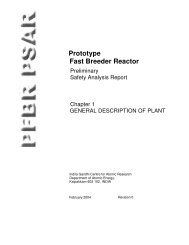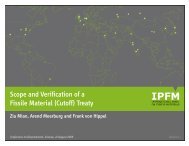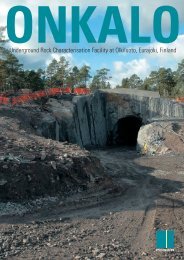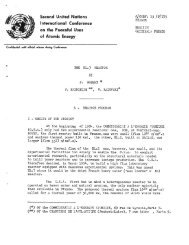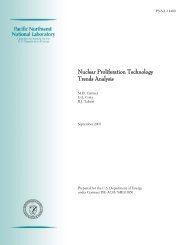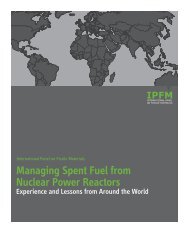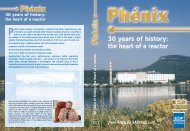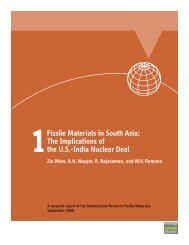Global Fissile Material Report 2009: A Path to Nuclear Disarmament
Global Fissile Material Report 2009: A Path to Nuclear Disarmament
Global Fissile Material Report 2009: A Path to Nuclear Disarmament
You also want an ePaper? Increase the reach of your titles
YUMPU automatically turns print PDFs into web optimized ePapers that Google loves.
If declarations are made early and new information as plants are cleaned out or newrecords are discovered is shared as well, this verification process could provide muchmore confidence than the large uncertainties in the declarations might at first suggest.Together with the knowledge gained concerning the material production complex, thisinitial verification stage will provide a firm basis of confidence upon which <strong>to</strong> build thenext, more detailed stage of verification.Once nuclear-weapon states release information on the production his<strong>to</strong>ries of materialsby site and facility, 132 and are ready <strong>to</strong> provide adequate access <strong>to</strong> these sites and/or provide representative samples of the fissile materials themselves—a more rigorousverification approach could begin. The “nuclear archaeology” methods that could beused for this purpose are the subject of Chapter 4.Figure 3.5. During the Cold War, the global inven<strong>to</strong>ryof atmospheric kryp<strong>to</strong>n-85 was known frommeasurements. Western analysts were able <strong>to</strong>estimate the amount of this kryp<strong>to</strong>n inven<strong>to</strong>ry associatedwith activities in the West, including reprocessingof military and civilian spent fuel. The sizeof the Soviet plu<strong>to</strong>nium s<strong>to</strong>ckpile therefore could beestimated from the remaining kryp<strong>to</strong>n inven<strong>to</strong>ry inthe atmosphere without any knowledge about theRussian production complex. 133Declarations: <strong>Fissile</strong> <strong>Material</strong>s versus <strong>Nuclear</strong> WeaponsAt some stage, states will have <strong>to</strong> make public their nuclear weapons holdings andproduction his<strong>to</strong>ry. Some states have already made a beginning. In a series of treatiesbeginning with the 1979 Strategic Arms Limitation Treaty (SALT), the United Statesand the Soviet Union agreed on numerical limits on their deployed nuclear forces, <strong>to</strong>disclose some information about their forces and accepted the need <strong>to</strong> facilitate verification.134 As part of the 1987 Intermediate <strong>Nuclear</strong> Forces Treaty (INF), the UnitedStates and Soviet Union exchanged data on the number, characteristics, locations andproduction facilities of intermediate-range and shorter-range missiles and associatedlaunchers and support structures. 135 There was an accompanying verification arrangementinvolving on-site inspections. 136 The 1991 START I treaty established limits on deployedU.S. and Soviet strategic weapons and created rules for counting these weaponsand for verification (Chapter 5). 13738 <strong>Global</strong> <strong>Fissile</strong> <strong>Material</strong> <strong>Report</strong> <strong>2009</strong>



